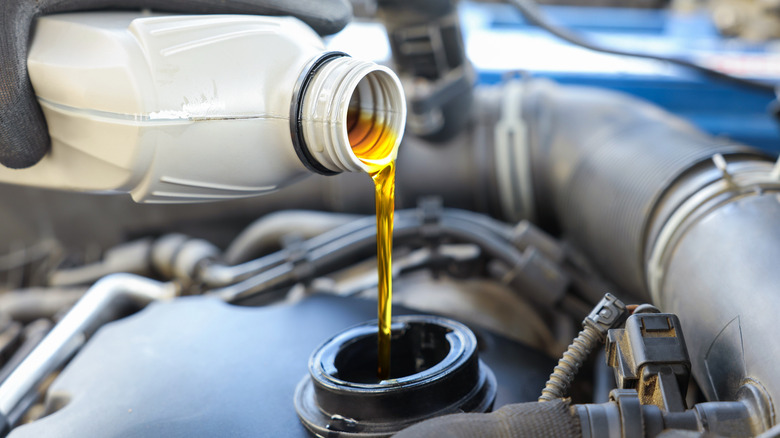Is Recycled Used Oil Just As Good As New Oil? Here's What You Need To Know
Due to its role in lubrication, friction reduction, and cooling, motor oil is crucial for engines. Without it, the internal parts would be subjected to extreme wear, resulting in damaged components, potential seizure, or even complete engine failure. Modern society depends on the substance to power machines used in various industries and transportation. This reliance is why every year, the U.S. goes through a staggering 1.35 billion gallons of used oil. While you can recycle used engine oil, America only reprocesses 800 million gallons, even though, with additional treatment, it can be as good as new oil.
The process of recycling used oil means reusing it for new purposes through reconditioning. This entails the use of machinery and systems that filter oil to remove non-soluble contaminants and impurities. This process, however, does not produce a product of the same level of quality as new oil and is applicable only for marine or diesel fuel and should not be used in automotive engines. For used oil to be suitable for combustion engine use, it will need to undergo a more thorough process called re-refining.
Used oil re-refining is an intensive, multi-phase procedure that purifies and creates base oil stock. The process starts with pre-treatment that uses filtration, settling, and centrifuging to remove impurities. Next, the oil undergoes a distillation stage using a heated vacuum to vaporize it, which separates the oil into three products. Afterwards, a catalyst and hydrogen gas are used to hydrotreat the oil under high pressure and temperature to remove contaminants and produce vacuum gas oil (VGO). The final stages of re-refining oil involve using solvents to remove any remaining impurities and blending in chemical additives to improve its quality and performance.
A sustainable source of lubricants
In terms of quality, recycled, re-refined oil has a lower carbon residue rating of 0.45 compared to the 0.89 of virgin oil, and a lower viscosity at 137.25 compared to the 185 of virgin oil. Lastly, it must pass the American Petroleum Institute's (API) Engine Oil Licensing and Certification System (EOLCS) before it goes to market. The end products of re-refining oil include base oil, which has additives mixed in and is sold as automotive engine lubricant; re-refined engine oil bottoms (REOB), a product used in asphalt binders for paving and roofing material; gas oil, commonly utilized as industrial and agricultural fuel; and as lubricants.
Numerous car maintenance myths include motor oil, but for the re-refined version, it is essential to note that its quality is comparable to, and can even exceed, that of new oil. Additionally, using this process can recover 65 to 75% of oil, which reduces the amount that's disposed of, which can become pollutants. As a more sustainable source of lubricants, the renewed substance also helps conserve natural resources and has a smaller carbon footprint during production compared to virgin oil.
For vehicle owners familiar with the advantages of regular oil changes, the availability of re-refined oil offers a more eco-friendly alternative to the popular synthetic and conventional options. Several car manufacturers, including Chrysler, GM, and Ford, allow the use of API-certified re-refined oil in their vehicles, with Mercedes-Benz indicating it has long approved its use. As the automotive industry shifts towards alternative fuels as a response to growing environmental concerns, the use of recycled or re-refined oil is another step towards less ecologically damaging use of vital lubricant oils.

